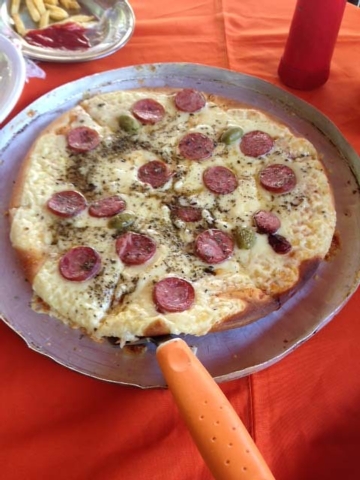Postcard from Brazil: Cuisine a delight of diversity
“There is no love sincerer than the love of food.”
– George Bernard Shaw, Man and Superman
One thing I was really looking forward to on this adventure was getting to try the many types of Brazilian food.
Brazil boasts a wide-ranging ethnic heritage that combines Portuguese olive oil, African okra, Italian pasta, Spanish soups, German sausage, Japanese sushi and other cultural tastes. The diversity makes for a delicious cuisine, which varies regionally.
Breakfasts have held the same on the trip with breads, meats, cheeses, fruits (bananas, watermelons, papayas), and eggs. The thick sucos (juices) have been much appreciated after nights of World Cup revelry. Our pousadas and hotels have all more or less served goiaba (guava), maracujá (passionfruit), acerola (a deep-red cherry-like fruit), abacaxi (pineapple), and cajá (a small fruit resembling a mango found in the Amazon rainforest).
The one constant at meals has been arroz e feijão (rice and beans), which it seems the Brazilians eat daily, mixed with onion, garlic, meats and seafood.
One of the first things I tried in Fortaleza was coxinha, a chicken croquette made in the shape of a drumstick. I can’t escape the smell of it and acarajé–fritters made with brown beans and shrimp fried in dendê (palm) oil–on the streets.
While in the beach town of Praia do Pipa, I gave moqueca a day in court. Moqueca is one of the most iconic Brazilian dishes, a traditional fish stew typically prepared in beautiful, rustic clay pots and features the characteristic ingredients of the northeast. The type of fish and seafood used varies according to personal preference and region. I sampled the moqueca baiana, which was seafood stew made with fish, onions, garlic, tomatoes, cilantro and chile pepper, and it was off-the-charts delicious.
In Recife, I dined at the popular cosmopolitan Entre Amigos restaurant along the Boa Viagem beach neighborhood and enjoyed a churrasco meal. Grilled meats known as churrasco or grelhadas is Brazilian barbecue in which chunks of beef are cooked on a metal skewer over hot coals. I’ve enjoyed it a few times at the Brazilian steakhouses in the Miracle Mile shops, the Mirage, and at the Palazzo. I tried the pork which was dredged in salt and grilled over a visible open fire. I rounded out the main course with a green salad and steamed vegetables and the experience was pleasurable.
During a meal shared with our friend Rey and his girlfriend Carla at the Mangai restaurant in Natal, I tried feijoada–the most famous and traditional of all Brazilian main courses. Feijoada is a thick black-bean stew with chunks of pork and other meats, and it was really delectable.
I shared a few pizzas on the journey with my cousin Drew, which used interesting combinations, and were always baked with green olives.
Some of the snacks I’ve enjoyed include the following: empadão (a tasty pie made from meat, vegetables, olives and eggs), pão de queijo (balls of cheese-stuffed tapioca bread), pastel (thin square of dough stuffed with meat, cheese or fish, then fried), and quibe (cracked wheat stuffed with spiced meat then deep-fried).
One condiment that is ever-present is farofa, a toasted manioc flour mixture sautéed in butter that is often prepared at home based on family recipes. Most recipes will contain varying amounts of salt, bits of egg, smoked meat and spices. The consistency of the mixture ranges from large grains to table-salt-sized powder. Most of the ones I’ve tried have a very smoky and slightly salty taste that accentuates the taste of barbecued meat and hearty stews.
Fresh aqua de côco (coconut juice) straight out of the punctured coconut has been available everywhere.
Brazilians enjoy their beer served bem gelada (icy cold) just as I do. Bohemia, Skol and Original are among the best national brands I drank, as well as the microbrew Devassa from Rio. Of course, my teetotalism was always in moderation…
The caipirinha is the unofficial Brazilian national drink. Ingredients are simple: cachaça (a high-proof sugarcane alcohol) with crushed lime, sugar and ice, and the results are sublime. Some choose to replace the cachaça with vodka (to make a caipirosca) or sake (to create caipisakes) and the lime with a variety of fruit.
Today, Rey shared a sort of dessert called “Romeo and Juliet” after our lunch at his house. Goiabada (a conserve made of guava and sugar) was combined with Minas cheese (produced in the Brazilian state of Minas Gerais). He then smeared it with a little Nutella and it was mouthwatering.
I know I could spend a lifetime here trying more of Brazil’s worldly cuisine in its regional variations, but the food I’ve enjoyed so far has been incredibly delightful!






















